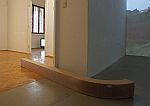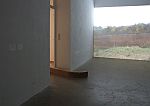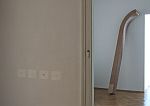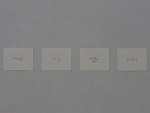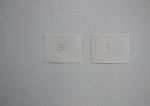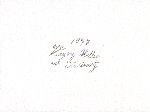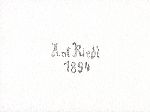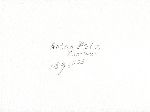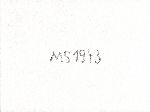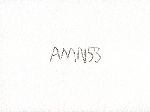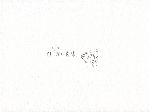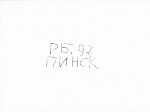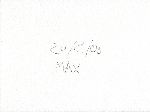Ink on watercolour paper, 2010/2011
series of 10 frottages, 10,5cm x 15,5cm
The series »Untitled I-X« translates historic graffitis, found in the fortress town of Theresienstadt/Terezín in Czech Republic, into drawing.
The monograms and dates that are carved and inscribed on the walls of the fortress, refer to anonymous witnesses of various periods that the city has gone through in the course of history (Monarchy of the Habsburgs, Czechoslovakia, Nazism, Communism, Czech Republic).
Quick guide through the history of Theresienstadt/Terezín
From 1780 onwards Theresienstadt was built during the reign of the Austrian Emperor Joseph II as a garrison town. It was named after Maria Theresia, mother of Joseph II and was supposed to protect the North-Western accesses to Bohemia against military attacks from Prussia.
1882 a waiver announced the rescission of the status of the town as fortress. A small garrison remained in the town and eleven barracks were provided for it. After the end of the First World War Terezín, the towns’ official name at that period, became a garrison town for the new Czechoslovak army.
In June 1940 the Nazis began to transform Theresienstadt into a concentration camp. In the little fortress they set up a prison of the Gestapo, where they imprisoned members of the Czech resistance against the occupation as well as war prisoners. In November 1941 the »Ghetto Theresienstadt« was built a collection and transit camp at first, especially for the Jewish population of Bohemia and Moravia. After the Wannsee Conference in 1942 old Jews as well as prominent Jews from Germany and other occupied European countries were also deported to the camp. In the Nazi propaganda in the German Reich Theresienstadt was transfigured into an »age ghetto« and presented to various foreign visitors as an alleged »Jewish settlement« during a brief period.
The Czechoslovak Republic (ČSR) was rebuilt after the Second World War and the Czech »Internment Camp of the Small Fortress Terezin« was set up in the »Small Fortress«. Until 1948 mostly German-speaking Czechs who have been driven out of Czechoslovakia were arrested there.
From June 1946 onwards the first Czech residents have started coming back to Theresienstadt/Terezín.
In 1948 the communists took over power. The ČSR was renamed into the Czechoslovak Socialist Republic (ČSSR) through the constitution of 1960 and communist leadership was established. In the official ideology of the ČSSR Theresienstadt was over 40 years mainly associated with the »Small Fortress« where the Gestapo prison was located. Practically only the memory of the Communist prisoners was preserved. The fact that there was a »Jewish ghetto« in its adjacent town Terezin (Theresienstadt) during the Second World War, was only mentioned in passing.
With the establishment of the Czech and Slovak Federal Republic (ČSFR from 1990 to 1992) and the Czech Republic (from 1992 up to now) the work of the memorial has also changed.
About 3000 residents are living in Terezín today. Some buildings of the town and the »Small Fortress« form the »Terezín Memorial«.
